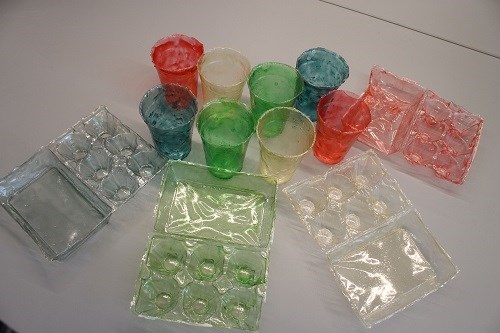Shrimp Shells Play Key Role In New Bioplastic
Substance that makes shrimp shells hardy used to make new bioplastic by Wyss Institute.
Researchers from Harvard University’s Wyss Institute have developed a fully-degradable bioplastic isolated from shrimp shells which they report can be molded into products such as cell phones, food containers and toys which boast many of the key properties as those made by their traditional plastic counterparts.
Director of platform development Bob Cunningham sees potential application for the new bioplastic for large-scale manufacturing of consumer products. The group is actively in the process of seeking potential partners, ranging from raw material suppliers and compounders to molders and end-users. Initially, the ideal partner would appear to be a compounder or resin supplier with bioplastics experience.
The new bioplastic is partly made of chitosan, a form of chitin, said to be Earth’s second most abundant organic material. A tough polysaccharide, chitin is responsible for the hardy shells of shrimp and other crustaceans, armor-like insect cuticles, and flexible butterfly wings. Led by postdoctoral fellow Javier Fernandez, and founding director Don Ingber, the Wyss team developed a new way to process the material so that it can be fabricated into large 3D objects and complex shapes using traditional casting or injection molding techniques. In addition, the chitosan bioplastic breaks down when returned to the environment within about two weeks, and it releases rich nutrients that support plant growth.
Depending on the chitosan fabrication method used, you either get a chitosan material that is brittle and opaque—thus, unusable, or tough and transparent, according to Fernandez. After fully characterizing in detail how factors like temperature and concentration affect the mechanical properties of chitosan on a molecular level, the two researchers honed-in on a method that produced a pliable liquid crystal material that was just right for use in large-scale injection molding or casting manufacturing.
Also significant is that they came up with a way to combat the problem of shrinkage whereby the chitosan polymer fails to maintain its original shape after injection molding. Adding wood flour did the trick! “You can make virtually mold any 3D form with impressive precision from this type of chitosan”, says Fernandez, who first molded a series of chess pieces as a demonstration. This bioplastic can also be modified for use in water and also can be easily dyed by changing the acidity of the chitosan solution. And the dyes can be collected again and reused when the material is recycled.

Want to find or compare materials data for different resins, grades, or suppliers? Check out Plastic Technology’s “Plaspec Global materials database”.
Related Content
-
PHA Compound Molded into “World’s First” Biodegradable Bottle Closures
Beyond Plastic and partners have created a certified biodegradable PHA compound that can be injection molded into 38-mm closures in a sub 6-second cycle from a multicavity hot runner tool.
-
US Merchants Makes its Mark in Injection Molding
In less than a decade in injection molding, US Merchants has acquired hundreds of machines spread across facilities in California, Texas, Virginia and Arizona, with even more growth coming.
-
Foam-Core Multilayer Blow Molding: How It’s Done
Learn here how to take advantage of new lightweighting and recycle utilization opportunities in consumer packaging, thanks to a collaboration of leaders in microcellular foaming and multilayer head design.















